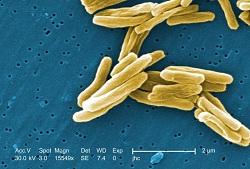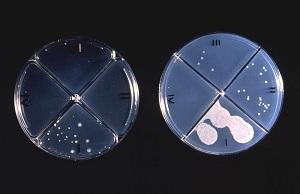Using AI to control energy for indoor agriculture
30 September 2024
Published online 13 April 2010

A 4,000-year-old disease continues to ravage populations around the world today, especially in poorer communities. The lack of research on new preventive and therapeutic measures is worsening the situation.
Tuberculosis (TB) is a serious, infectious disease caused by a certain type of bacteria called Mycobacterium tuberculosis. It often attacks the lungs, but can be found in other organs such as the stomach, reproductive system or bones.
"TB is a very old infectious disease, it was even found in mummies from ancient Egypt. This problem is still living with us as we have failed to control it," said Ghina Mumtaz, who is a research specialist in the Infectious Disease Epidemiology Research Group at the Weill Cornell Medical College in Qatar (WCMC–Q). "Today one-third of the world has TB."
The major vaccine used against TB is nearly 100 years old. Most of the therapeutic antibacterial drugs that are currently used against it were developed nearly 50 years ago.
"[TB] used to be of high incidence in Europe and the United States. At that time, many of the drugs were developed. That all happened in the first part of the twentieth century. By the beginning of the second part of the century, TB was close to elimination in many of these rich countries," explained Laith Abu-Raddad, who is an assistant professor in the Department of Public Health at WCMC–Q.
"This was quite a big triumph for humanity because we almost managed to stop TB. But that was a problem for the rest of the world. Funding for TB research dropped to almost zero. This is quite a disgrace in public health."
Recently released global estimates for the year 2008 put the annual number of new infections at 9 million, mostly in sub-Saharan Africa and Asia. Around 2 million people die annually due to the disease. One-third of the world's total population is thought to be currently infected by the bacteria.
"This is sadly a common problem with many diseases. If a disease does not affect the West, it gets very little research," added Abdelhady Mesbah, who is a microbiology and immunology consultant in Egypt. "Malaria kills 5 million people every year. But because they are mostly in Africa, very little research is invested in it."
Infections with new multiple-drug-resistant strains of TB can take up to 2 years to treat.
However, a USD 900 million investment by the Bill and Melinda Gates Foundation to eradicate TB by 2050 is renewing research efforts to fight the bacteria.
Abu-Raddad led a group of researchers to determine which new interventions had the best possibility of achieving these targets. The team looked at new vaccines and therapeutic drugs in the pipeline, and new TB diagnostic methods.
"In infectious diseases, vaccines are usually the best option. But the first vaccine developed was very disappointing. It had a 60% efficacy and that was not going to eliminate TB," said Abu-Raddad.
The new vaccine is also neonatal, meaning that it can be given only to babies, while the bulk of the disease is in young males. Although it might have very good results in the long term, it will not meet the 2050 target. In the most optimistic tests that the team ran, it was going to reduce TB by only 40%.
New therapeutic drugs offered better results; however, although they were predicted to help treatment, they were not going to eliminate the disease completely.
"We found the highest impact would be in TB diagnosis," said Abu-Raddad. "We have a long list of diagnostic methods, but only 70% of cases around the world are being diagnosed. That means that 30% are not diagnosed and keep transmitting the disease."
Early diagnosis would give a larger window for early and successful intervention, decreasing the transmission and the spread of the disease.
"We can move from a passive system to an active system, where we can screen many people easily. But we can expect that to take maybe 10 years to develop. It is quite complicated and has a lot of basic science involved in it," said Abu-Raddad.
He quickly points out that all these interventions follow a classical disease approach, which might not be enough to eliminate TB. A drug to address latent infections would also be important, as they act as a reservoir for the virus, which might become active anytime that the immune system is weakened.

CDC
According to Hiam Chemaitelly, who is an epidemiologist in the Infectious Disease Epidemiology Research Group at WCMC–Q, the Middle East region ranks fourth worldwide in regards to disease burden and mortality. The successful implementation of several United Nations programmes helped to reduce the disease.
However, there has been a considerable surge in infection rates in the region lately. Mesbah attributes this to the widespread smoking of water pipes, along with malnutrition and unhealthy living conditions. The immune cells in the cilia in the lungs become weaker due to smoking, therefore becoming more susceptible to infection.
Multiple-drug-resistant (MDR) strains are also starting to appear, especially in areas where the human immunodeficiency virus (HIV) is prevalent. The virus causing acquired immunodeficiency syndrome (AIDS) weakens the immune system, opening up a chance for strains that have developed resistance from previous medications to become active again.
"These highly resistant strains now make up nearly 2% of new TB infections," stressed Mesbah. "Normally, the therapeutic drug regimens we currently have take 6 to 9 months to control the disease. But with infections with these new resistant strains, treatment can take up to 2 years."
"The main concern is that all these new varieties of TB bacteria are evolving and we cannot address them with current drugs," added Chemaitelly.
Abu-Raddad explained that several new drugs in the pipeline, which are funded by the Bill and Melinda Gates Foundation, can potentially address these new strains. One of them can potentially also reduce treatment time to just 10 days. However, the first of these, which should appear next month, will not address resistant strains.
"Unfortunately these things take quite a while in safety tests, clinical tests, etc.", he said. "By 2015 to 2020 we might be able to develop a drug that can stop these strains."
doi:10.1038/nmiddleeast.2010.136
Stay connected: